I want to acknowledge the Kenaitze Indian Tribe, descendants of the Kahtnuht’ana Dena’ina, as the rightful stewards of the land encompassing Resurrection Pass. I honor their ancestral connection and ongoing presence in this territory.
This past July, I decided to run the entirety of Resurrection Pass in one day, from Cooper Landing to Hope. Since I became interested in point-to-point runs in the Alaskan mountains, Resurrection Pass stood out as the pinnacle of long trails in Southcentral Alaska. Once used as a popular mining corridor, the 38 mile mountainous trail now is predominantly used for recreation; and compared with a recent trip to McCarthy, I saw no signs of the old mining days. Outside of the iconic wilderness of the trail, the question arises: why would one decide to run 38 miles in one day?
In July 2022, a sudden, undesired change upended my life. It turned my world upside down and my mind and heart inside out.
Earlier that spring, I finally stepped away from a high level cross country ski racing career. For almost three years, I had “tried” to quit skiing. The pandemic thwarted my first attempt in 2020, and personal fear and anxiety over the loss of identity and societal validation, as well as the glimmer of a potential spot on a second Olympic team, kept me chasing a dream that, in retrospect, wasn’t my dream.
In 2022, while I unsteadily navigated the challenging transition away from a skiing career and the life of a competitive athlete that defined my last 15 years, the plans for “the rest of my life” were taking root: a cross country move, new job and big travel plans on the horizon, all with my person next to me. All of those plans vanished when my partner unexpectedly decided he wanted a different future.
As my life exploded, so did my mind. With the huge privilege of time and space to absorb and mourn my loss, I found myself adrift in a turbulent sea of grief and panic. I lost sight of the narrative that had once guided me. A narrative that wove together exploration, adventure, and a life and possible future family with my partner: my foundation for the last 7 years.
Friends and family came to my side, but I had never known this type of darkness and profound despondency. Immediately, all my plans, hopes and dreams for my life vanished. As a type-A human who previously pursued achievement after achievement, I had no structure on how to move forward. My partner and I had dreamt up our lives together. I had no solo backup plan – and no desire for a different life.
Immediately, within weeks of the acute mental breakdown, I tried to attack back with a regime of therapy, medications, yoga and all the self care ideas I could find. A “yes, and” paradigm ran through my days. I clung to hope in order to survive and simultaneously felt delusional, confused and dejected. My body itself seemed to revolt. I lost all interest in food due to constant nausea and the ability to sleep vanished. Whenever I ran or hiked, I would end up flat on my face, my sense of balance gone. The black hole sucked me in deeper and deeper. Regardless of all my attempts to fix myself, depression and anxiety have no immediate cure, and grief has no timeline.
I found myself in the Lower 48, living out of a car (by choice), falling deeper and deeper into severe depression and anxiety. Grief guided my actions from impulsive, dangerous decisions, to days spent non-functional. I teetered between moods of total disregard for my life, like attempting to climb and then falling off a 25 foot cliff alone in the wilderness of Mount Hood on my 31st birthday, to struggling to get out of bed in the morning after another night of no sleep. Both types of being reflected my utter lack of desire to find out what life would now look like.
The one steady thing I had in my life was nature. I often slept at trailheads and on forest service roads, finding trails to run or hike before my daily drive, or the hours I spent working remotely at libraries and cafes all over the small towns of the West. Sometimes these runs consisted of me walking along sobbing uncontrollably, whereas other times I found a moment of peace when I plunged into a beautiful alpine lake in the Tetons or a ray of sunshine illuminated the lush Oregon forest. Nature reminded me of the inevitable death and rebirth cycle as I watched late summer in the Pacific Northwest shift to autumn in Wyoming and Utah. And in November, I felt winter take hold during a stint in Girdwood, Alaska. In December, when I lived in New Mexico for a month, on each morning outing, I watched the cacti lay dormant while the desert awaited the return of summer heat.

Fast forward to July of this year: I had arrived back in Alaska after 3 months of solo travel in South America. The return home was going as smoothly as I expected, which is to say it was a challenge. I dreamed of feeling how I once felt about Alaska: filled with joy, gratitude and love for this beautiful place and the good fortune I had to build a life here. But memories of past lives don’t really fade and our somatic bodies know more than our conscious minds can attune to.
In late July, a close friend called to tell me of her plans to camp in Cooper Landing and Hope over the weekend. Immediately, I realized this would be the perfect opportunity to run Resurrection Pass. I’ve run from Devil’s Pass to Cooper Landing twice, and both times were a bit brutal even though I was in good shape from ski training. As I am not training anymore, the thought of running 38 miles seemed ridiculous. But, after a Friday night Hope Social Club concert at Hilltop where singer Melissa Mitchell told me to “just live your dreams, be wild and free”, I impulsively drove down to Devil’s Pass trailhead at 10pm and fell asleep in the back of my car.

Rising early, I picked up my friend and headed to the trailhead. The plan was for her to run out seven miles to Trout Lake with me, then return and drive my car from Cooper Landing to Hope while I continued on solo. The kicker: it was pouring rain, about 45-50 degrees, the visibility was nonexistent and the trail was a river of mud. Determined, I refused to consider that I wouldn’t complete the run, and after a painful ankle twist and face plant into a deep puddle at mile 5, I dug in even deeper.
I saw the run as a catharsis. Approaching my 32nd birthday the next weekend, I had just survived the most challenging year of my life thus far. I was exhausted throughout the months as I continued to rebuild my life, begrudgingly at times, enthusiastically at other moments. I still battled internally with the heavy trauma of the year and the growing integration of the “old” me and the “new” me. When my friend turned around at mile 7, I gazed ahead at a swampy trail towards Juneau Lake, nine miles in, wondering just how “messed up” I must be to contemplate carrying on.
What can you do but keep running? Just as in life, sometimes we don’t get to make decisions to leave our situation or headspace. We are stuck in the muck (quite literally during my trail run) and the only way out is through.
Author Cheryl Strayed writes, “Acceptance is a small quiet room.”
Acceptance can also be a long trail in the middle of the Alaskan wilderness with cold rain piercing your face and your legs growing heavier by the minute.
But again, do you stop? No, because that is frankly not an option. I was 10-15 miles from the nearest road, dangerously cold and soaking wet. And there was no guarantee of a pick-up if I attempted to hitchhike to Hope.
Depression involves navigating through difficult emotional landscapes; running Resurrection Pass involves navigating through difficult natural landscapes.
I had never been on the segment of the trail from Devil’s Pass to Hope, so when I hit the halfway point, half frozen, the uncertainty of the rest of the trail felt formidable. In my life, this is where my anxiety surfaces – a fear of the unknown future, trying to cope with things yet to occur. But, as in running, in life you don’t get to stop the clock – you just keep moving forward as gracefully as possible.
After mile 10, navigating around puddles ceased to matter. I eventually became drenched enough to stride right into the deepest ones. I’d part the cow parsnips towering over me, and slip and slide down the river that was once a trail. Amidst this, unexpected moments of serenity would surface. While fog and heavy clouds engulfed the mountains with somber undersides, the burst of a vibrant primrose fireweed would catch my eye as I slid past. Or the abundance of mushrooms adorning the mossy banks of the trail descending into Hope. Or a shared grimace with a fellow trail user, acknowledging the imperfect conditions and our shared determination to be out there. These small interactions connected me with the life around me. Similar to the new friendships that I’d formed over the last year, these fellow hikers and runners witnessed a transformed version of me – a person who carries grief. Someone who continues forward into the unknown and simultaneously misses the blissful ignorance of my younger self. It is the shared human experience of yearning for belonging and safety intertwined with a profound desire for the untamed, even fierce, wilderness that envelopes us.
The setting mirrored my inner landscape this year. Instances of immense and almost unbelievable beauty contrasted sharply with periods of affliction or grief, which at best felt uncontrolled, and at worst, resembled a tumultuous overthrow of my mental well-being.
The trail passes from the 2019 Swan Lake burn to the beautiful banks of Juneau Lake, up to the alpine of Devil’s Pass with its picturesque Forest Service log cabin, and through the corridor of the Alaskan tundra to the midpoint. Descending down towards Hope, evergreen forests quickly usher in a steep canyon on the left of the trail. The sound of rushing waterfalls rises until the trail reaches a series of creek canyons that pop up and down from a mossy evergreen forest to creek beds full of overgrowth. On my run, with each passing mile moving through the varying landscapes, fatigue started to envelop my mind. Much like a state of meditation, thoughts flowed in and out, as I lacked the strength to hold onto any one of them for an extended period. The reverberating plea from my body was a tired, “Can we stop soon?” to which my mind replied, “Not until the trail ends.”
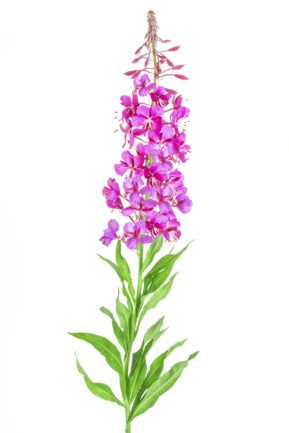
Fascinatingly, the absence of autonomy in shaping my future has played a pivotal role in my experience of depression and grief. Emerging from this is a sense of despair, as if the vibrancy of life will never return; my rose-colored glasses have been shattered. Resurrection Pass illustrated this concept to me, though with an added metaphorical observation; while today might be draped in shadows and rain, tomorrow or the upcoming weeks or months, could unveil a path adorned with plentiful blueberries and scarlet fireweed.
Finally, I arrived at the flowing banks of Resurrection Creek, a river big enough to signal the terminus of the trail. Strangely, I found myself not wanting the experience to end. I knew that upon arriving at the parking lot in Hope, I would have to disconnect from this absent state and re-enter my life. The minute I would stop, the overwhelming exhaustion would overtake my body and I’d return alone to my house sitting place in Anchorage without revelry. No one to celebrate my intense experience with. A dual struggle arose. Every step I took was a bitter step closer to the end, yet my body ached to cease moving. Eventually, without much fanfare, I crossed the bridge to the parking lot, soaking wet and mud covered, with 38 more miles in my legs.
Trails like Resurrection Pass give us the opportunity to explore our limits —discovering places where solitude offers us the prospect of personal growth. While not everyone crossing the trail will complete it in a single day, each will unearth something unknown. Whether that is building connections with fellow travelers, realizing the confidence to go into the backcountry alone, or simply enjoying a piece of Alaska steeped in history, from the stewardship of the Den’nina People to the miners of the early 1900s to the countless visitors today. The importance of these natural spaces cannot be understated.
This narrative of Resurrection Pass, while personal, resonates universally. It’s a reminder that life’s journey is defined not by the destination but by the steps taken along the way. Just as the trail draws us closer to nature, it also reconnects us with ourselves. Resurrection Pass illuminated the symbiotic relationship between the paths I tread and the stories I script. In every stride along the trail, I found a reflection of life’s journey—a reminder that we are not only observers of our surroundings but active participants in our own narratives, even when that participation feels futile. As we explore the world, we simultaneously delve into the depths of ourselves, realizing that every step forward is an act of resilience and self-discovery. It’s a reminder that amidst life’s uncertainties, the trail remains steadfast, offering a space for introspection, growth, and connection.
As for my personal story, the Res Pass trail reinforced the idea that life is always a journey into the unknown filled with both darkness and light. It is my choice to wake up each morning and choose self compassion and patience to allow the path to unfold gracefully. While I move through this difficult season of my life, simultaneously an abundance of opportunity surrounds me. With each passing day, I create more community in Alaska. From the regular students at my evening yoga classes, to my Mountain View Boys & Girls Club kids who each week give me the healing gift of laughter, to new (and old) friends of all ages and backgrounds who share their own stories of deep hurt and continued resilience – my path shines with light.
Running Resurrection Pass didn’t “heal” me. Nor did three months of solo travel in South America or taking psychedelics with shamans or driving across the West lost and alone. Regardless of how I feel about it, last year’s events will shape my life forever. Similar to the natural world, the best we can do is move through whatever weather comes our way with the people, passions and places that hold us through it all. Resurrection Pass is now one of those places for me.
My gratitude extends to the Dena’ina People, who stewarded this land, and to all those who have preserved this trail’s essence. Resurrection Pass isn’t just a physical passage; it’s where the footprints of countless adventurers intersect, leaving an imprint not only in the mud but also on the hearts of those who journey. Trails like this are both teachers and healers, gilding us towards embracing life’s vast, intricate tapestry.
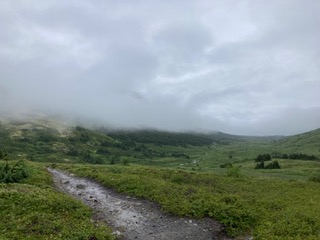
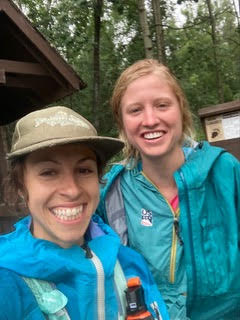
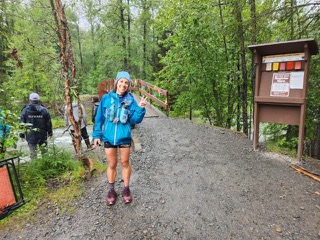
-Rosie Frankowski

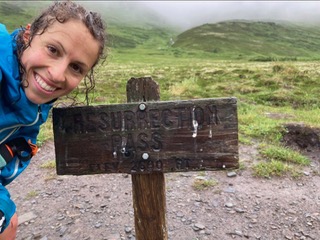
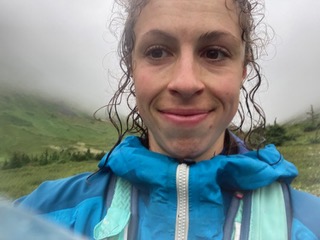 A spirited ball of energy, Rosie has embraced Alaska as her home (for now) since 2014. Originally from Minnesota, Rosie came to Alaska on a whim to cross country ski race for APU Nordic Ski Center and raced in the 2018 Olympics and in the World Cup for four seasons. In 2022, she stepped away from competitive ski racing amidst an earthquake of change in her personal life, and found herself on a yearlong journey through the western United States and eventually South America. She continues to explore Alaska’s trails and also enjoys teaching yoga, foraging, rollerblading, eating Thai food and painting.
A spirited ball of energy, Rosie has embraced Alaska as her home (for now) since 2014. Originally from Minnesota, Rosie came to Alaska on a whim to cross country ski race for APU Nordic Ski Center and raced in the 2018 Olympics and in the World Cup for four seasons. In 2022, she stepped away from competitive ski racing amidst an earthquake of change in her personal life, and found herself on a yearlong journey through the western United States and eventually South America. She continues to explore Alaska’s trails and also enjoys teaching yoga, foraging, rollerblading, eating Thai food and painting.